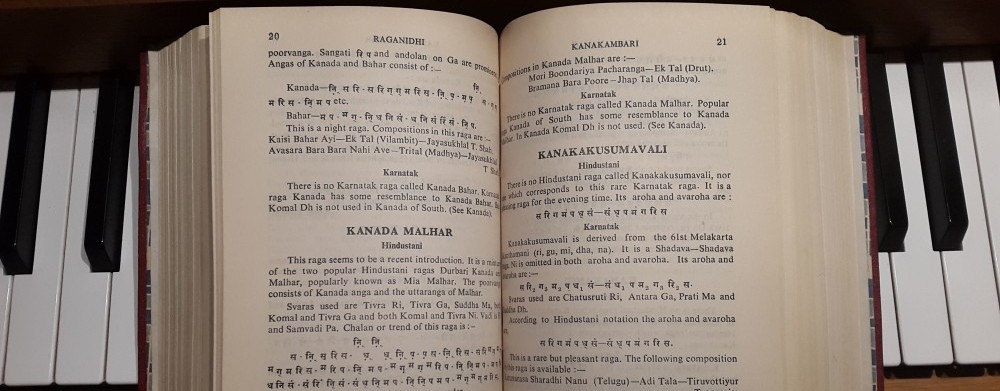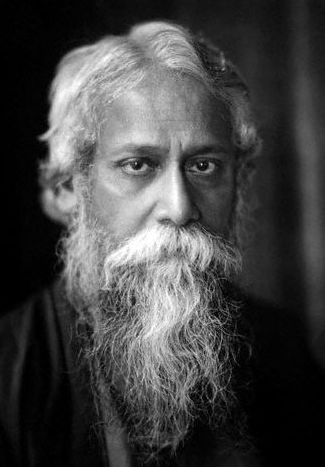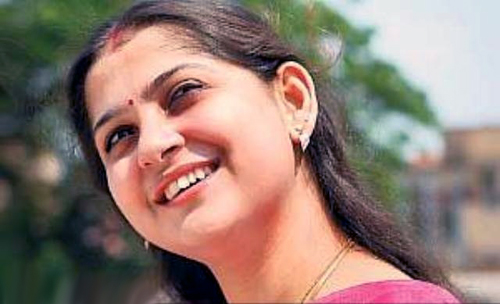Een van mijn eerste programma’s die ik maakte voor De Concertzender, opgedoken in mijn thuisarchief: de West-Afrikaanse harpluit, de kora – aflevering uit de programmareeks ‘Metamorfosen’, uitgezonden op De Concertzender op 7 oktober 1993.
Samenstelling, tekst en produktie: Pieter de Rooij.
Presentatie: ?
Tag Archives: radio
From the Hoboken Collection : Arnold Bake’s radiotalk (script) on Rabindranath Tagore
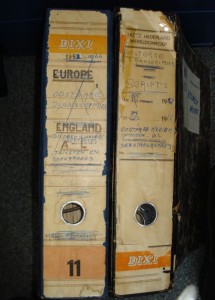
It’s certainly been too long – but better late, than never – since I announced to write on some of the interesting documents I found three years ago at Radio Netherlands from the legacy of Peter van Hoboken (1901-1994), Head of Transcription Service at Radio Netherlands from 1948 to 1966 and one of the great pioneers and promotors of Indian classical music in the Netherlands*. For several decades already there has been another and bigger Van Hoboken-collection that is incorporated in the Felix van Lamsweerde-collection, but most of the material that I came across at Radio Netherlands is different and therefore an interesting addition to the material that was known already.
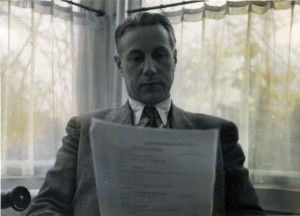
Peter van Hoboken in his office at Radio Netherlands
From here I’d like to refer to these documents as the Radio Netherlands Hoboken Collection, abbreviated as RNHC. My find in January 2002 of a unique recording by Radio Netherlands in 1957 of sitarist Ravi Shankar already illustrated the great value of Peter van Hoboken, who organised this recording. As an adept of Indian classical music and dance Van Hoboken organised recordings of concerts in The Netherlands and he produced many Radio Netherlands programmes on Indian classical music.
At this point I want to proceed with some interesting documents I found among the RNHC, concerning radiotalks done in 1950 by world famous dutch ethnomusicologist Arnold Bake (1899-1963), radiotalks Bake did in english and hindi about the musical life and culture of India, recorded for the Radio Netherlands Transcription Service to be distributed to presumably India and Surinam for broadcasts by stations over there. What I found of these radiotalks is only paperwork, Bake’s typed scripts along with his handwritten corrections. Unfortunately, the recorded tapes can’t be found in the Radio Netherlands Audio Archives, as these were sent to stations outside Holland, the main task of the Transcription Service.
It’s a great pity the recordings of Bake can’t be found in the archives of Radio Netherlands. I’ve asked Felix van Lamsweerde and they’re not in his Van Hoboken Collection. I would assume that they could have been stored in the Arnold Bake Archives, kept at the University of Leiden, but Felix and another expert, Fred Gales, told me that the collection over there contains only papers of radiotalks and not recordings. So, if not in Hilversum and not in Leiden, where can they be? Did the Radio Netherlands Transcription Service sent them to All India Radio and/or to Surinam or are they kept somewhere at the University of London’s School of Oriental & African Studies where Bake lectured? At this point I can’t believe they’re lost. I hope they can be found somewhere, as I’d like to hear how the scripts I found in Hilversum come alive in a radio transmission with Bake’s voice and with the music he talks about.
The radiotalk-script I like to present here contains Bake’s thougths on India’s world famous writer, poet, philosopher and Nobelprize winner Rabindranath Tagore (1861 – 1941), in particular on ‘Tagore and his music’ and when I publish this it’s 7 May 2011, precisely the 150th birthday of Tagore. So, yes, this update on the RNHC took me too long, but I think I’m right on time with presenting these particular papers. 🙂
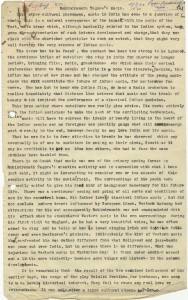
scriptpage 1, click a few times on the photo to enlarge
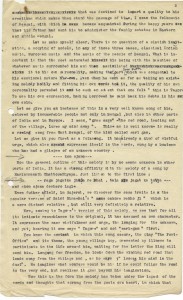
scriptpage 2, click a few times on the photo to enlarge
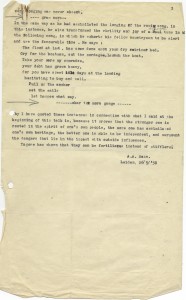
scriptpage 3, click a few times on the photo to enlarge
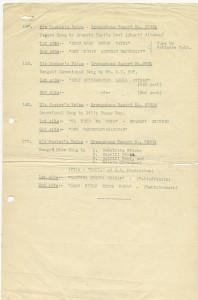
scriptpage 4, click a few times on the photo to enlarge
Let me add that I consider my short writings here on the RNHC as a work in progress. I don’t wanna pretend that I know all the details or have all the answers. That would be stupid and a false claim. If someone sees mistakes or things I overlook or has interesting additional information, please let me know.
* Radio Netherlands and Peter van Hoboken’s son Alexander have given me permission to publish these documents and write about them.
De Concertzender: muziek van topkwaliteit uit alle periodes en alle richtingen!
Voor elk wat wils bij de Concertzender. Zoals de kraan water geeft, zo geeft de Concertzender muziek. Muziek van topkwaliteit uit alle periodes en richtingen. Kijk maar es naar onderstaande promo.
The most wonderful ‘Serenade in Blue’
I catched this on tape from radio thirty years ago… now isn’t this the most wonderful ‘Serenade in Blue’ ?
German radio WDR3 portrays phenomenal ragasinger Kaushiki Desikan Chakrabarty
On tuesday 23 November 2010 at 23.05 PM German public radiostation WDR3 portrays phenomenal 30-year old (and my favourite) ragasinger Kaushiki Desikan Chakrabarty from Calcutta.
Earlier, on 10 November 2010 WDR3 devoted a radio evening on Kaushiki, with a live broadcast of her concert in Bielefeld, a very beautiful performance that was described by renowned ragaspecialist Jan Reichow as “Das außergewöhnlichste, ergreifendste, intelligenteste, fröhlichste, innovativste Konzert Europas”. He’s not exaggerating. Kaushiki has it all and when you hear her live on stage her voice is able to touch your heart and soul deeper than you ever could have imagined… I’m saying this with great conviction as I’m speaking from my own wonderful experiences with hearing Kaushiki live in concert (at the Darbar Festival in 2008 in Leicester, and in 2007 in the Tropentheater in Amsterdam).
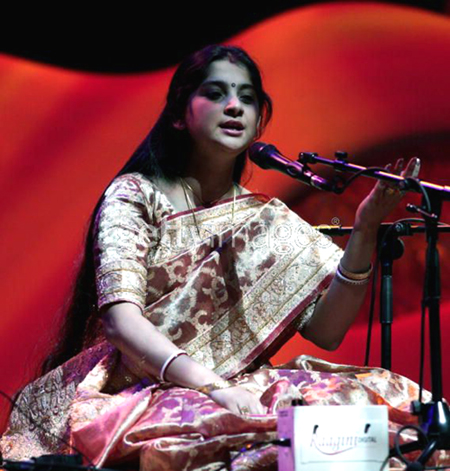
Kaushik performing in London in 2005, after she received the BBC3 World Music Award
WDR3 radio provides the following information for the radiobroadcast on 23 November 2010: Kaushiki Desikan Chakraborty gehört zu den großen Talenten der jungen Generation. Im Gegensatz zu früher dürfen Nachwuchskünstler heute schon viel früher ihr Können öffentlich zeigen. Kaushiki ist erst 30 Jahre alt und schon eine anerkannte Sängerin auf den großen Bühnen Indiens. Sie hat eine betörende Stimme und ein für ihr Alter ungewöhnliches technisches Vermögen. Die Pflege der alten Tradition ist ihr erklärtes Ziel. In diesem Sinne ist sie, obwohl jung, eine wertkonservative Künstlerin – mehr noch: sie trägt mit ihrer Haltung zum Überleben des klassischen indischen Geangs bei. Anlässlich ihres Bielefelder WDR-3-Konzerts vor knapp zwei Wochen erzählte Kaushiki unserer Autorin Clair Lüdenbach von ihrer Kunst und aus ihrem Leben.
If you like ragamusic you really should listen on tuesday 23 November at 23.05 PM to this WDR3-radio broadcast devoted to Kaushiki.
WDR3 live-radiobroadcast ragaconcert Kaushiki 10 November 2010 in Bielefeld
Her voice and music are breathtaking and soultouching and of a heartbreaking beauty, to put it mildly.
Kaushiki sings raag Multani in Amsterdam, 2007
In the past couple of years I’ve tried to tell about Kaushiki’s extraordinary musical powers in some of my writings on the web etc , in my programme Gharana and in this radioprogramme. Phenomenal Patiala ragasinger Kaushiki Chakrabarty from Calcutta performs in Bielefeld (Germany) on Wednesday 10 November and this concert will be broadcasted live on WDR3 Radio, starting at 8.05 PM.
Kaushiki sings ‘Yaad Piya Ki Aaye’ in Amsterdam, 2007
I like the way WDR Radio has tried to put in words the qualities of Kaushiki: “Die Sängerin Kaushiki aus Kolkata hat eine phänomenale Stimme und die stupende Fähigkeit, jede Nuance der großen traditionellen Form- und Melodiemodelle perfekt umzusetzen, von expressiven Wendungen, die ins herz treffen, bis zu Läufen und Koloraturen, die mit atemberaubender Geschwindigkeit ablaufen.” A very true, good description.
If you happen to like ragamusic the WDR-radiotransmission is not-to-be-missed!
Kaushiki performs a bhajan in bhairavi, concert in Amsterdam, 2007
British newspaper recognises stature of dutch radio pioneer Ate Doornbosch
It’s quite amazing that the best newspaper coverage on the demise of dutch folksong collector and radiomaker Ate Doornbosch (1926-2010) comes from an overseas neighbour: British music journalist Ken Hunt wrote an excellent obituary about Ate Doornbosch for the British newspaper The Independent. To read this obituary, click here.
I think it’s regrettable that the dutch national NOS Journaal of public television broadcasting didn’t report on television on Ate Doornbosch’s passing away.
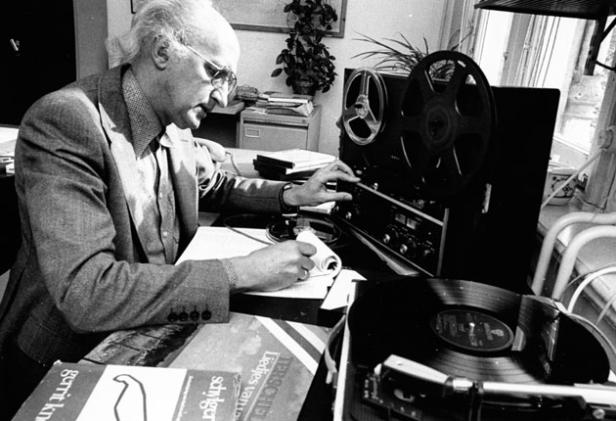
Ate Doornbosch, busy transcribing
Of the big dutch newspapers (Telegraaf, Volkskrant, Parool, Trouw, NRC) only NRC published a short obituary. Still, without any doubt Ate Doornbosch was a figure of national importance. He became famous with his radio programme ‘Onder de Groene Linde’, that ran 1316 times between 1957 and 1993 and in its heydays attracted 350.000 listeners per episode. It was the longest running radio programme ever on dutch national radio.
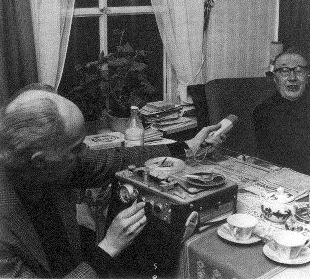
Ate Doornbosch recording old dutch folksongs at the people’s homes
“Few folk-song collectors anywhere match Doornbosch’s achievement, the public face of which was the long-running radio series Onder de Groene Linde (“Under the green linden”) and “his work was fairly compared to that of the US collector Alan Lomax”, writes British music journalist Ken Hunt about Ate Doornbosch in the aforementioned obituary.
It’s great to see that a foreign newspaper fully recognises the meaning and stature of the pioneering work of Ate Doornbosch. Here’s the link to the obituary once more.
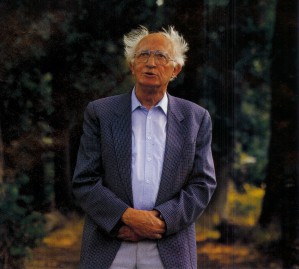
Ate Doornbosch in 1990
* outside of the dutch press and media the only extensive dutch obituary I found is this one, written by professor Louis Grijp of the Meertens Instituut in Amsterdam.
Liedjesjager en radiomaker Ate Doornbosch overleden
“Liederen uit de hele wereld klinken in de huizen. Wie heeft er nog aandacht voor een traag oud lied, dat vroeger de lange winteravonden kortte of een eindeloze werkdag op het land?”
Op 23 juli 2010 is op 84-jarige leeftijd de Nederlandse radiomaker en volkskundige Ate Doornbosch overleden. Hij is op 29 juli gecremeerd. Doornbosch presenteerde van 1957 tot 1993 dertienhonderdzestien keer het populaire radiopogramma ‘Onder de Groene Linde’ waarin hij overal in Nederland mensen thuis bezocht en opnamen maakte van door henzelf gezongen, mondeling overgeleverde liederen. Doornbosch legde op die manier zo’n 5000 traditionele liederen vast. Zijn inspanningen leverden een imposant archief op dat in Amsterdam wordt beheerd door het P.J. Meertens Instituut.
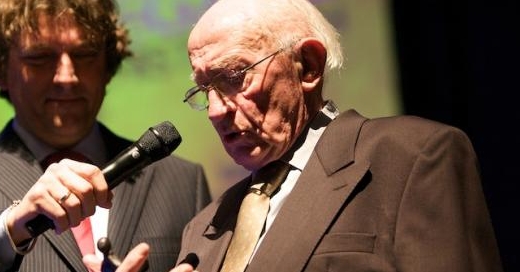
Ate Doornbosch ontvangt in 2009 een Edison voor zijn werk
Playing around India : A portrait of Dutch cellist Saskia Rao-De Haas (2002)
Playing around India – A portrait of Dutch cellist Saskia Rao-de Haas, a radio documentary by Pieter de Rooij, produced in 2002. [original Dutch title: Op streek in India – een portret van de Nederlandse celliste Saskia Rao-de Haas]
The documentary is mostly in dutch, but this video offers a transcript in english locked to the timetable, in order to make this production accessible for an international audience. To allow convenient reading of this transcript, you should play the video in HD (1080p).
Production date: May-June 2002. First broadcast by Concertzender on 8 November 2002, also broadcast by Radio Netherlands on 25 and 29 December 2002. Voice narrator: Wim Vriezen.
In the documentary ‘Playing around India’ (produced May-June 2002) programme maker Pieter de Rooij introduces the career of the brilliant 31-year-old (that is, in 2002) cellist Saskia Rao-de Haas. She is one of the very few people, and the only European, to play the classical ragas of North India on the cello. She is considered the only genuine cello soloist by the Indian concert going public. Her virtuosity and deep musicality have introduced a new resonance to Indian music and have been enthusiastically receieved by critics and audiences worldwide. To achieve a proper Indian sound Saskia Rao-de Haas plays on a specially modified cello: smaller (so as to be able to be played sitting on the floor), with five instead of the usual four strings, and with ten ‘sympathetic’ strings. These freely resonating strings give a beautiful Indian sound to the cello and the instrument has quickly become very popular.
For two years (speaking from 2002) Saskia Rao-de Haas has lived in New Delhi with her husband, the famous Indian sitar player Shubhendra Rao. As well as traditional raga improvisations, she and her husband play their own compositions in which they mix classical Indian music with elements from European folkmusic and Western classical music.
In May and June 2002 Saskia and Shubhendra toured outside India when, for the first time, Western audiences were able to hear the combination of sitar and cello in Indian classical music. Programme maker Pieter de Rooij caught up with the couple in Amsterdam where they gave a concert at the KIT Tropen Theatre on 25 May. Saskia talks about her music, her cello and her life in India. Her husband Shubhendra, the violin maker Eduard van Tongeren and her former teacher at the Rotterdam Conservatory, Joep Bor, all have something to say about Saskia’s amazing cello adventure. Recordings from the Amsterdam concert are heard during the documentary.
Facebook profile ragamusic-programme ‘Gharana’
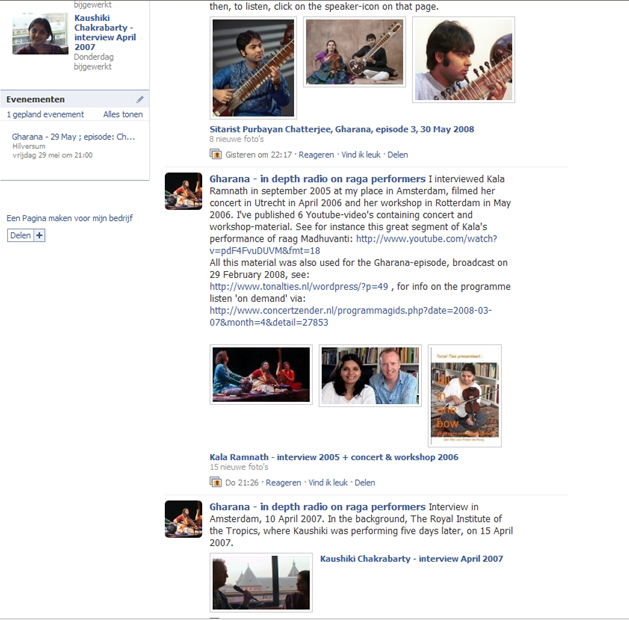
A segment of the Facebook profile-page of ‘Gharana’
Yesterday I’ve created a Facebook profile on my Concertzender radioprogramme Gharana. The profile-page is named ‘Gharana – in depth radio on raga performers’. For an impression of the programme watch the Gharana-promo-video on Youtube.
If you like raga music and like to know more about my programme, feel free to join the Gharana Facebook-profile as a member. I’d love to welcome you there!
